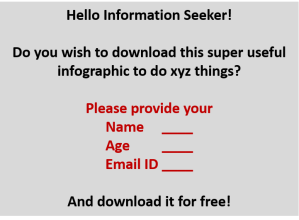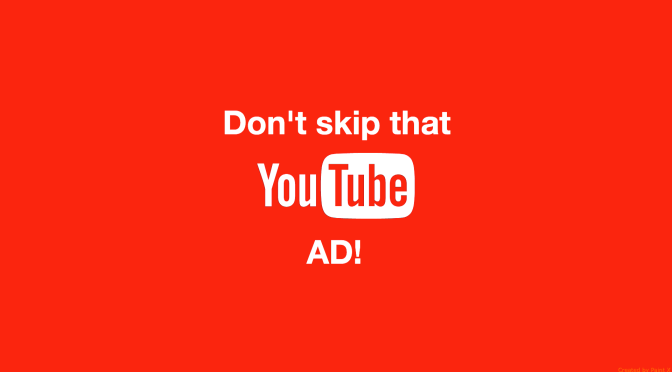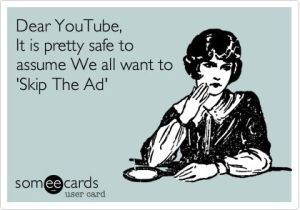The above prompt may seem all too familiar to some of you. Especially if you’ve tried searching for internet trends, how to’s or any other industry best practices.
What you are witnessing is data collection 101. This is primary information that companies focussed on “lead nurturing” are interested to capture. The idea is to provide something of utility to the consumer and in return get personal identifiers like Name, Email id etc. In a lot of cases, the content given to the user (for free) is actually quite useful and may have required a sizeable investment in time and energy. That makes you wonder, how is this a viable Marketing strategy?
Is it fathomable that we are entering the golden era of marketing wherein empowerment of consumers is the primary goal for companies?
Well, the answer to that is yes and no.
Yes, because many companies, especially technology companies, are increasingly getting aware of the fact that in order to get more takers for their technology there needs to be sizeable investment behind evangelising and training consumers on how to use the technology. Some great examples of this in action are from companies like Hootsuite, Hubspot, Salesforce etc. Whilst smaller technology companies have been pioneering this effort, larger brands are yet to join the bandwagon.
No, because there are 3 specific reasons that are making email ids the most coveted piece of information for marketers.
Reason #1: The launch of Google Customer Match
Email ids used only as a means of sending a promotional email once in a while is passe. Now with the launch of Google Customer Match, email ids act as your personal identifier and Google has the ability to target ads specific to you on Search, Youtube and across the Google display network. These are exciting times because we have moved very quickly from just cookie targeting to a personal identifier targeting across the web.
With the email id acting as your personal identifier, it makes all the sense for Marketers to chase after this information and design strategies exclusively for data collection and profiling of consumers, giving rise to the much talked about field of “Data-driven Marketing.”
Reason #2: Customizable audience creation
Facebook custom audiences and Twitter tailored audiences do exactly what Google Customer Match does but restricted to their respective platforms. This gives companies the capability to create lists of customer email ids basis similarities and then using these lists to run targeted and customised communication. What’s more is that Facebook & Twitter can populate a list of audiences that are similar to your customer list (lookalike audiences) basis demographics, interests and preferences allowing you to run a campaign for acquiring these new customers.
Personally, I think this is great. I am smart enough to share my email id only with brands that I trust and care about. So if this makes those brands reach me more efficiently and break the clutter then by all means go ahead! Going forward, at no point do I wish to see an ad for a shaving gel. I mean why? It’s such a waste of my time and the marketers advertising money. Show me what interests me with lesser frequency and I’m a happy camper!
Reason #3: Tracking your customer’s engagement levels via emailers
In-email analytics are now more crucial than ever. Sending a promotional newsletter to your consumers? You need to be tracking the following:
- How many of them open your email? Get an opening rate and analyse that over time against days and time of the day. Target consumers that open your email with related ads on the web (using their email id) and keep the conversation going. Needless to say, overexposure always has and always will be a terrible thing. So practice moderation and keep your communication actionable.
- A/B test your Promo Codes. Are you sending promo codes with your email? Create customer clusters and use different promo codes (with different promo values) for those clusters. Track how they perform, analyse which promo values work on which clusters and arrive at an optimum combination of cluster and promo value based on the redemption rates.
- Analyse all actionable items in the email and have unique identifiers for links as per the identified customer clusters. See which one performs better than the rest for each cluster. Intuitive changes like placing those action items in prominent positions in your emailer can enhance your conversation rates.
Lastly, I’m sure this whole piece has raised some serious data privacy concerns in your mind. The general notion on this matter would be, first you target me on my laptop then my smartphone and now you basically plan to target me wherever I sign in with my email id! Whilst paranoia of being tracked is understandable, let me leave you with this thought:
Hating on the existence of advertising is naive, but can we work towards making it cleaner? Making it a more pleasant experience for the consumers, brands and everyone else involved. With Marketing strategies developed on the back of consumer data, I think we can.
Would love to hear your point of view on this. Comment below!
Image courtesy: http://feldmancreative.com/wp-content/uploads/2014/02/Email-Marketing.jpg



